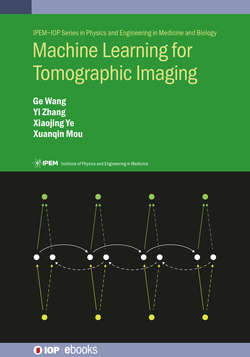Читать книгу Machine Learning for Tomographic Imaging - Professor Ge Wang - Страница 15
На сайте Литреса книга снята с продажи.
0.4 The field of deep reconstruction and the need for this book
ОглавлениеThe industrial revolution from the eighteenth century onwards has greatly accelerated civilization, and now we are in the intelligence revolution, synergizing big data, exploding information, instantaneous communication, sophisticated algorithms, high-performance computation, and AI/ML. Over only the past few years, as AI/ML methods have become mainstream, deep learning has affected many practical applications and generated overwhelming excitement (figure 0.5). As a result, more and more students and researchers are motivated to learn and apply AI/ML.
Figure 0.5. A Web of Knowledge search, with ‘deep learning’, ‘medical’, and ‘imaging’ as the topic terms (data collected on 11 July 2019).
Our field is tomographic image reconstruction, which is experiencing a paradigm shift towards deep-learning-based reconstruction (see our perspective on deep imaging (Wang 2016)). Simply speaking, we are interested in developing deep learning methods going from measured features to tomographic images. Currently, deep learning techniques are being actively developed worldwide for tomographic image reconstruction, delivering excellent results (figure 0.6, and also see (Wang et al 2019)).
Figure 0.6. Web of Knowledge search, with ‘deep learning’ in the article title (data collected on 11 July 2019).
While many of us share optimism about this new wave of tomographic imaging research, there are doubts and concerns regarding deep reconstruction. This conflict of opinions is natural and healthy. In retrospect, at the beginning of the development of analytic reconstruction, there was a major critique that given a finite number of projections, the tomographic reconstruction is not uniquely determined (introducing ghosts in a reconstructed image). Later, this was successfully addressed by regularization methods. When iterative reconstruction algorithms were first developed, it was observed that a reconstructed image was strongly influenced by the penalty term. In other words, it seemed that what one saw was what one wanted to see! Nevertheless, by optimizing the reconstruction parameters, iterative algorithms have been made into commercial scanners. As far as compressed sensing is concerned, it was proved that there is a chance that a sparse solution is not the truth. For example, a tumor-like structure could be introduced, or pathological vessels might be smoothed out if total variation is overly minimized. Similarly, deep learning appears to present issues in practice, such as the interpretability problem. No Maxwell equations for deep learning yet exist, and a deep network as a black box is trained to work with big data in terms of parameter adjustment. The interpretability of neural networks is currently a hot topic. Given the rapid progress being made in theoretical and practical aspects, we believe that deep learning algorithms will become the mainstream for medical imaging.
With the encouraging results and insights, some of which are in this book, we are highly confident that, in principle, AI/ML methods for deep reconstruction ought to outperform iterative reconstruction (IR) and compressed sensing (CS) for medical imaging. To convince the reader that AI/ML will dominate tomographic imaging, let us highlight three key arguments: (i) IR/CS can be used as a component in a neural network (such as in our ‘LEARN’ network in chapter 5); (ii) the result from IR/CS can be used as the baseline (such as for the denoising, despeckling, or de-blurring networks mentioned in several chapters in this book); and (iii) IR/CS reconstruction algorithms can be enhanced or even replaced by powerful neural networks with advanced architectures trained with big data with unprecedented domain priors.
There are a good number of deep learning books of high quality. However, they are either on general deep learning methods or other specific deep learning applications. This book is dedicated to the emerging area of deep reconstruction, representing a new frontier of machine learning, and offers a unified treatment of this theme. In particular, this book is focused on medical imaging, which is a primary example of tomographic imaging that affects all people worldwide, spans a huge business, and remains a major driver for technical innovations.
